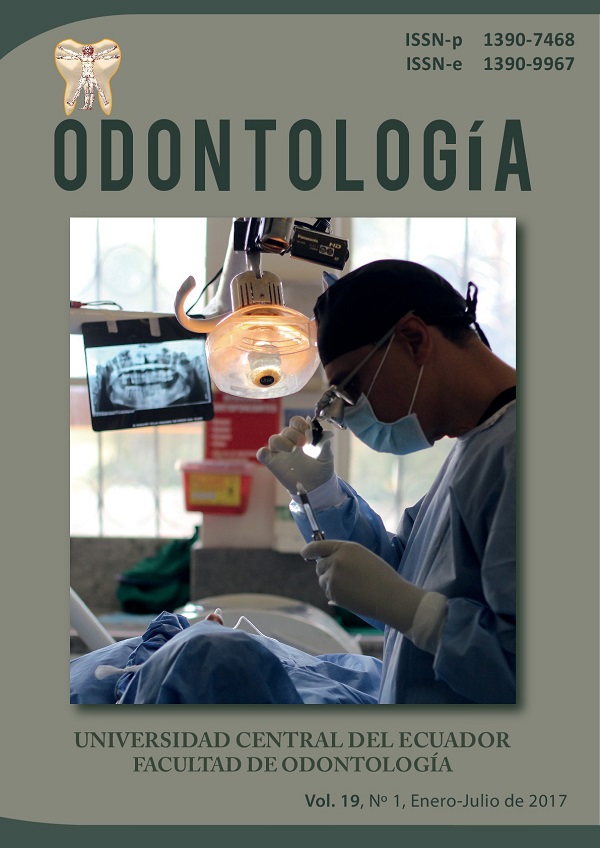Estudio de las propiedades antimicrobianas de la Camellia sinensis en un modelo microbiano oral
Palabras clave:
Phytotherapy, Streptococcus mutans, Candida AlbicansResumen
Objetivo: Determinar el efecto antibacteriano in vitro del extracto de Camellia Sinensis (té verde) sobre un modelo de microflora oral. Materiales y métodos: Fueron utilizados dos extractos etanólicos de té verde de diferente procedencia (Perú y China), en concentraciones de 16, 8, 4, 2, 1, 0.5 y 0.25mg/ml. Se evaluaron la concentración mínima y máxima inhibitoria sobre cepas de S. mutans, S. mitis, C. albicans, C. tropicalis, S. aureus, F. nucleatum, L. rhamnosus, L. casei, C. glabrata y E. faecalis. Los datos obtenidos fueron analizados estadísticamente utilizando la prueba estadística Kruskal Wallis con un nivel de significancia de 5%. Resultados: La C. sinensis mostró un efecto bacteriostático para las cepas de S. mutans, y fungiestático para C. albicans, C. tropicalis y C. glabrata. (p<0.05). Conclusión: El extracto etanólico de 16mg/ml de Camellia Sinensis presenta efecto inhibitorio sobre cepas de S. mutans, C. albicans, C. tropicalis y C. glabrata.
Descargas
Citas
Piatkowska E, Rusiecka-Ziolkowska J. Influence of Essential Oils on Infectious Agents. Adv Clinical Exp. 2016; 25(5):989-95.
Anita P, Sivasamy S, Madan Kumar PD, Balan IN, Ethiraj S. In vitro antibacterial activity of Camellia sinensis extract against cariogenic microorganisms. J Basic Clin Pharm. 2014; 6(1):35-9.
Araghizadeh A, Kohanteb J, Fani MM. Inhibitory activity of green tea (Camellia sinensis) extract on some clinically isolated cariogenic and periodontopathic bacteria. Med Princ Pract. 2013;22(4):368-72.
Sicca C, Bobbio E, Quartuccio N, Nicoló G, Cistaro A. Prevention of dental caries: A review of effective treatments. J Clinical Exp Dent. 2016; 8(5):e604-e10.
Legenova K, Bujdakova H. [The role of Streptococcus mutans in the oral biofilm]. Epidemiologie, mikrobiologie, imunologie: casopis Spolecnosti pro epidemiologii a mikrobiologii Ceske lekarske spolecnosti JE Purkyne. 2015;64(4):179-87.
Espinoza MS, León RAM. Prevalencia y experiencia de caries dental en estudiantes según faet cultades de una universidad particular peruana. Rev Estomatol Herediana. 2015; 25(3):187-93.
Duarte MC, Figueira GM, Sartoratto A, Rehder VL, Delarmelina C. Anti-Candida activity of Brazilian medicinal plants. Journal of ethnopharmacology. 2005;97(2):305-11.
Steinmann J, Buer J, Pietschmann T, Steinmann E. Anti-infective properties of epigallocatechin-3-gallate (EGCG), a component of green tea. Br J Pharmacol. 2013;168(5):1059-73.
Ricardo PMP. Efecto antibacteriano in vitro del extracto de té verde (camellia sinensis) en comparación con el gluconato de clorhexidina al 0.12% sobre el streptococcus mutans en el laboratorio microbiológico de la UCSM, 2011.: Universidad Católica de Santa María; 2011.
Ferrazzano GF, Roberto L, Amato I, Cantile T, Sangianantoni G, Ingenito A. Antimicrobial properties of green tea extract against cariogenic microflora: na in vitro study. J Med Food. 2011; 14(9): 907-11.
Awadalla HI, Ragab MH, Bassuoni MW, Fayed MT, Abbas MO. A pilot study of the role of green tea use on oral health. Int J Dent Hyg. 2011; 9(2): 110-6.
Antunes DP, Salvia AC, de Araújo RM, Di Nicoló R, Koga Ito CY, de Araujo MA. Effect of green tea extracted and mouthwash without alcohol on Candida albicans biofilm on acrylic resin. Gerodontology. 2015; 32(4): 291-5.


